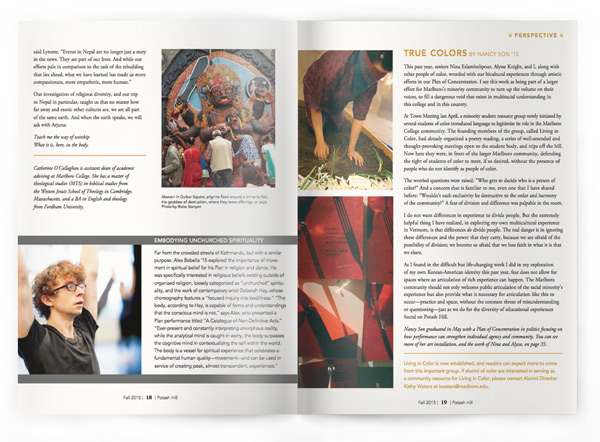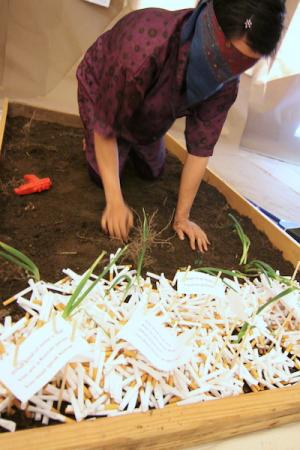True Colors

By Nancy Son ’15
 This past year, seniors Nina Eslambolipour, Alysse Knight, and I, along with other people of color, wrestled with our bicultural experiences through artistic efforts in our Plan of Concentration. I see this work as being part of a larger effort for Marlboro’s minority community to turn up the volume on their voices, to fill a dangerous void that exists in multiracial understanding in this college and in this country.
This past year, seniors Nina Eslambolipour, Alysse Knight, and I, along with other people of color, wrestled with our bicultural experiences through artistic efforts in our Plan of Concentration. I see this work as being part of a larger effort for Marlboro’s minority community to turn up the volume on their voices, to fill a dangerous void that exists in multiracial understanding in this college and in this country.
At Town Meeting last April, a minority student resource group newly initiated by several students of color introduced language to legitimize its role in the Marlboro College community. The founding members of the group, called Living in Color, had already organized a poetry reading, a series of well-attended and thought-provoking meetings open to the student body, and trips off the hill. Now here they were, in front of the larger Marlboro community, defending the right of students of color to meet, if so desired, without the presence of people who do not identify as people of color.
The worried questions were raised: “Who gets to decide who is a person of color?” And a concern that is familiar to me, even one that I have shared before: “Wouldn’t such exclusivity be destructive to the order and harmony of the community?” A fear of division and difference was palpable in the room.
I do not want differences in experience to divide people. But the extremely helpful thing I have realized, in exploring my own multicultural experience in Vermont, is that differences do divide people. The real danger is in ignoring these differences and the power that they carry, because we are afraid of the possibility of division; we become so afraid that we lose faith in what it is that we share.
As I found in the difficult but life-changing work I did in my exploration of my own Korean-American identity this past year, fear does not allow for spaces where an articulation of rich experience can happen. The Marlboro community should not only welcome public articulation of the racial minority’s experience but also provide what is necessary for articulation like this to occur—practice and space, without the constant threat of misunderstanding or questioning—just as we do for the diversity of educational experiences found on Potash Hill.
Nancy Son graduated in May with a Plan of Concentration in politics focusing on how performance can strengthen individual agency and community. You can see more of her art installation, and the work of Nina and Alysse, on page 35.
Living in Color is now established, and readers can expect more to come from this important group. If alumni of color are interested in serving as a community resource for Living in Color, please contact Alumni Director Kathy Waters.
